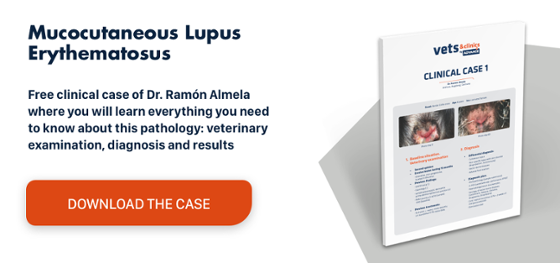Examining for Demodex canis or canine demodicosis
What is Demodex canis?
It is a parasitic disease caused by the excessive proliferation of Demodex canis mites inside the hair follicles. The exaggerated multiplication is caused by genetic and/or immunological factors, as the parasite is normally found living in the follicles of most healthy dogs. Transmission takes place during the first hours of life by direct contact with the mother. The disease can manifest with various clinical signs.
There is a localised form that usually affects puppies before they reach 6 months and courses with focalised lesions. And there is a generalised form that affects young dogs under 1 year or adults and elderly animals that have an internal disease, tumour or which are taking immunosuppressive treatments. There is both a breed-specific (German Shepherd, Old English Sheepdog, Collie, Dalmatian, Great Dane, Boxer, Dobermann, Afghan, etc.) and an inherited predisposition.
Canine demodicosis: diagnosis
The signs that should arouse suspicions of Demodex canis include alopecia, erythema and seborrhoea. In the generalised form, sometimes there are systemic signs, such as fever, lymphadenopathy, depression and anorexia. It is usually accompanied by deep pyoderma resulting in pododermatitis that affects digital and interdigital areas.
- Adhesive tape impressions: an alternative diagnostic method: The classic technique for detecting the presence of Demodex canis is deep skin scraping. However, an adhesive tape impression after squeezing the skin is a good diagnostic alternative. This was highlighted in a study that compared the sensitivity (90% for deep skin scrapings and 100% for adhesive tape impressions) and total number of mites detected using each technique.
Canine demodicosis: treatment
In the localised form, it is advisable not to treat with amitraz baths as most cases heal spontaneously. Topical benzoyl peroxide can be used to control secondary pyoderma and an amitraz collar may help.
In the generalised form and in pododermatitis, treatment consists of amitraz baths after thoroughly cleaning the skin with benzoyl peroxide to make sure the amitraz comes into contact with the parasite. The application must be repeated every 2 weeks until the skin scrapings are free from any parasites. The administration of vitamin E at a dose of 200–400 mg/dog every 8 hours may also help. Recently, the use of ivermectin at high and frequent doses (600 µg/kg/day PO; SC) has proven effective in the treatment of generalised demodicosis, especially in amitraz-restistant cases.
Prognosis
The prognosis is good, and even in severe, amitraz-refractory cases of generalised forms thanks to treatment with ivermectin. Animals with demodicosis should not be used as breeding animals.


